2015 Peugeot 208 ABS
[x] Cancel search: ABSPage 32 of 341
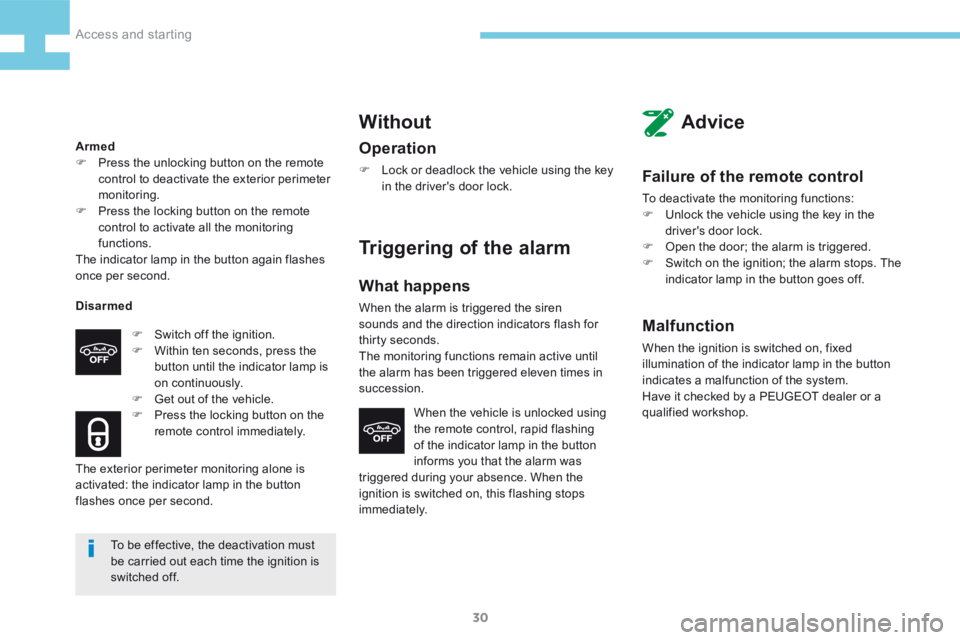
30
208_en_Chap02_ Acces-Demarrage_ed01-2015
Armed
F Press the unlocking button on the remote
control to deactivate the exterior perimeter
monitoring.
F Press the locking button on the remote
control to activate all the monitoring
functions.
The indicator lamp in the button again flashes
once per second.
Disarmed
F Switch off the ignition.
F Within ten seconds, press the
button until the indicator lamp is
on continuously.
F Get out of the vehicle.
F Press the locking button on the
remote control immediately.
The exterior perimeter monitoring alone is
activated: the indicator lamp in the button
flashes once per second.
To be effective, the deactivation must
be carried out each time the ignition is
switched off.
Without
Operation
F Lock or deadlock the vehicle using the key
in the driver's door lock.
Triggering of the alarm
What happens
When the alarm is triggered the siren
sounds and the direction indicators flash for
thirty seconds.
The monitoring functions remain active until
the alarm has been triggered eleven times in
succession.
When the vehicle is unlocked using
the remote control, rapid flashing
of the indicator lamp in the button
informs you that the alarm was
triggered during your absence. When the
ignition is switched on, this flashing stops
immediately.
Advice
Failure of the remote control
To deactivate the monitoring functions:
F Unlock the vehicle using the key in the
driver's door lock.
F Open the door; the alarm is triggered.
F Switch on the ignition; the alarm stops. The
indicator lamp in the button goes off.
Malfunction
When the ignition is switched on, fixed
illumination of the indicator lamp in the button
indicates a malfunction of the system.
Have it checked by a PEUGEOT dealer or a
qualified workshop.
Access and starting
Page 43 of 341
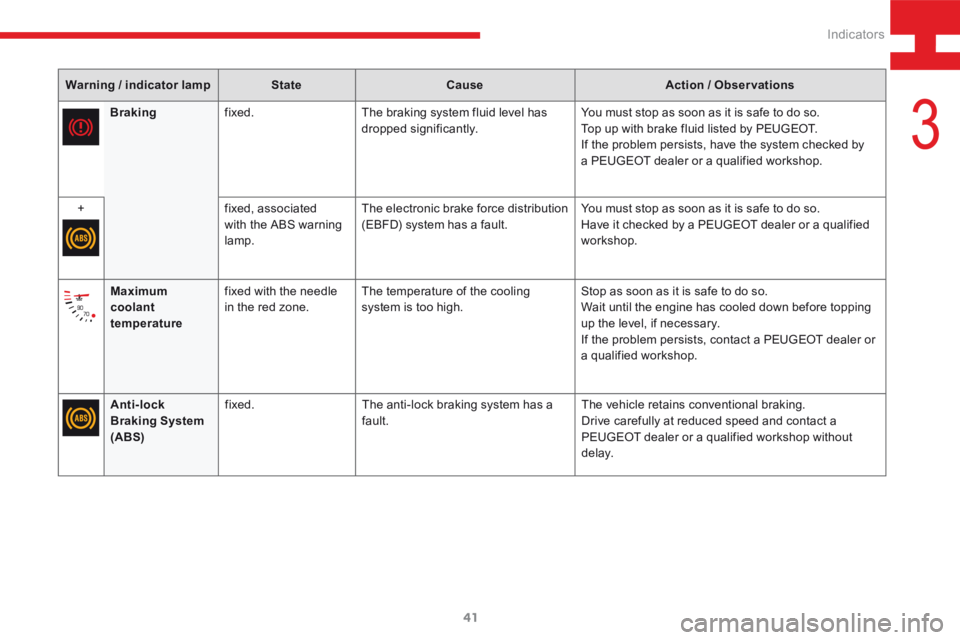
41
208_en_Chap03_Indicateurs_ed01-2015
Warning / indicator lampStateCause Action / Observations
Braking fixed. The braking system fluid level has
dropped significantly. You must stop as soon as it is safe to do so.
Top up with brake fluid listed by PEUGEOT.
If the problem persists, have the system checked by
a PEUGEOT dealer or a qualified workshop.
+ fixed, associated
with the ABS warning
lamp.The electronic brake force distribution
(EBFD) system has a fault.
You must stop as soon as it is safe to do so.
Have it checked by a PEUGEOT dealer or a qualified
workshop.
Maximum
coolant
temperature fixed with the needle
in the red zone.
The temperature of the cooling
system is too high. Stop as soon as it is safe to do so.
Wait until the engine has cooled down before topping
up the level, if necessary.
If the problem persists, contact a PEUGEOT dealer or
a qualified workshop.
Anti-lock
Braking System
(ABS) fixed.
The anti-lock braking system has a
fault. The vehicle retains conventional braking.
Drive carefully at reduced speed and contact a
PEUGEOT dealer or a qualified workshop without
d e l ay.
3
Indicators
Page 135 of 341
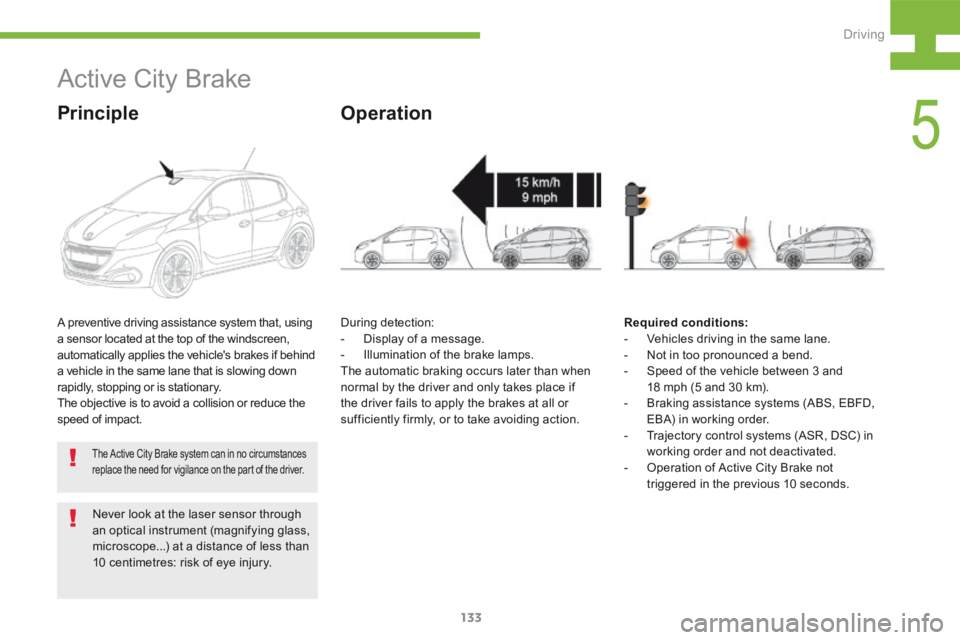
133
208_en_Chap05_conduite_ed01-2015
Never look at the laser sensor through
an optical instrument (magnifying glass,
microscope...) at a distance of less than
10 centimetres: risk of eye injury.
Active City Brake
Principle
A preventive driving assistance system that, using
a sensor located at the top of the windscreen,
automatically applies the vehicle's brakes if behind
a vehicle in the same lane that is slowing down
rapidly, stopping or is stationary.
The objective is to avoid a collision or reduce the
speed of impact.
The Active City Brake system can in no circumstances
replace the need for vigilance on the part of the driver.
Operation
Required conditions:
- Vehicles driving in the same lane.
- Not in too pronounced a bend.
- Speed of the vehicle between 3 and
18 mph (5 and 30 km).
- Braking assistance systems (ABS, EBFD,
EBA) in working order.
- Trajectory control systems (ASR, DSC) in
working order and not deactivated.
- Operation of Active City Brake not
triggered in the previous 10 seconds.
During detection:
-
Display of a message.
- Illumination of the brake lamps.
The automatic braking occurs later than when
normal by the driver and only takes place if
the driver fails to apply the brakes at all or
sufficiently firmly, or to take avoiding action.
5
Driving
Page 138 of 341
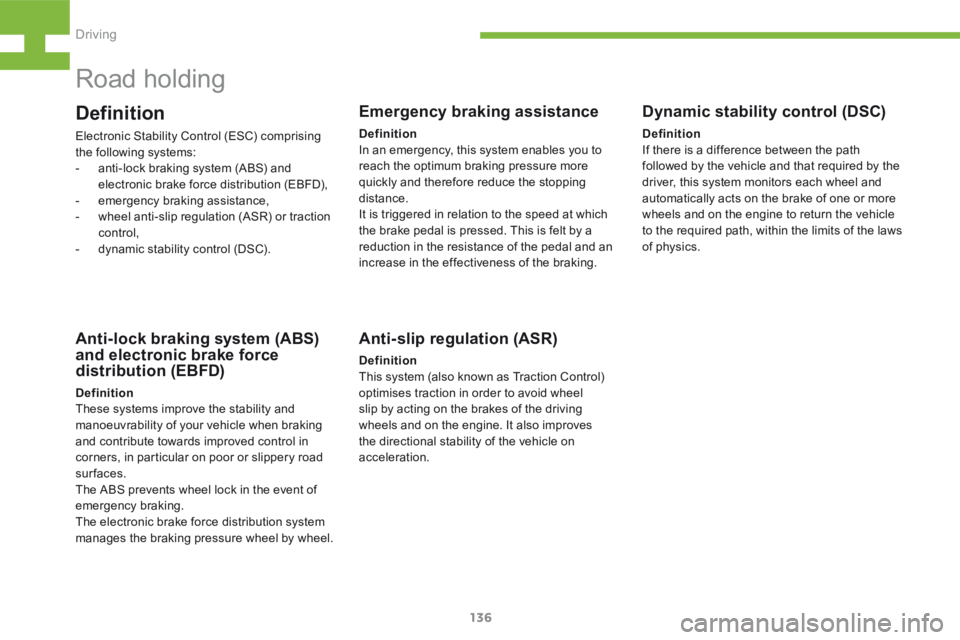
136
208_en_Chap05_conduite_ed01-2015
Road holding
Definition
Electronic Stability Control (ESC) comprising
the following systems:
- anti-lock braking system (ABS) and
electronic brake force distribution (EBFD),
- emergency braking assistance,
- wheel anti-slip regulation (ASR) or traction
control,
- dynamic stability control (DSC).
Anti-lock braking system (ABS)
and electronic brake force
distribution (EBFD)
Definition
These systems improve the stability and
manoeuvrability of your vehicle when braking
and contribute towards improved control in
corners, in particular on poor or slippery road
surfaces.
The ABS prevents wheel lock in the event of
emergency braking.
The electronic brake force distribution system
manages the braking pressure wheel by wheel.
Emergency braking assistance
Definition
In an emergency, this system enables you to
reach the optimum braking pressure more
quickly and therefore reduce the stopping
distance.
It is triggered in relation to the speed at which
the brake pedal is pressed. This is felt by a
reduction in the resistance of the pedal and an
increase in the effectiveness of the braking.
Anti-slip regulation (ASR)
Definition
This system (also known as Traction Control)
optimises traction in order to avoid wheel
slip by acting on the brakes of the driving
wheels and on the engine. It also improves
the directional stability of the vehicle on
acceleration.
Dynamic stability control (DSC)
Definition
If there is a difference between the path
followed by the vehicle and that required by the
driver, this system monitors each wheel and
automatically acts on the brake of one or more
wheels and on the engine to return the vehicle
to the required path, within the limits of the laws
of physics.
Driving
Page 139 of 341
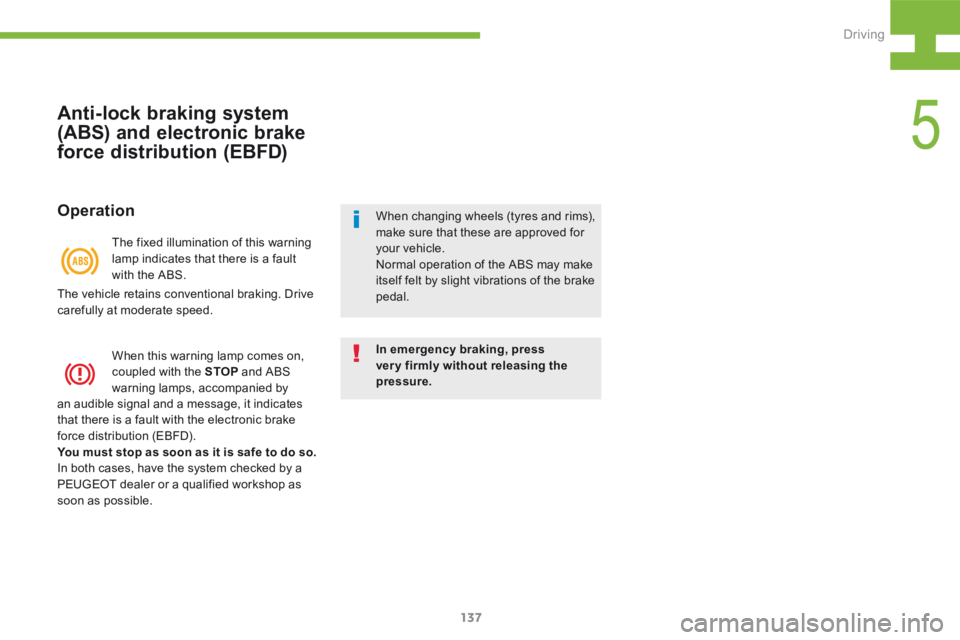
137
208_en_Chap05_conduite_ed01-2015
Anti-lock braking system
(ABS) and electronic brake
force distribution (EBFD)
Operation
In emergency braking, press
very firmly without releasing the
pressure. When changing wheels (tyres and rims),
make sure that these are approved for
your vehicle.
Normal operation of the ABS may make
itself felt by slight vibrations of the brake
pedal.
The fixed illumination of this warning
lamp indicates that there is a fault
with the ABS.
When this warning lamp comes on,
coupled with the STOP
and ABS
warning lamps, accompanied by
The vehicle retains conventional braking. Drive
carefully at moderate speed.
an audible signal and a message, it indicates
that there is a fault with the electronic brake
force distribution (EBFD).
You must stop as soon as it is safe to do so.
In both cases, have the system checked by a
PEUGEOT dealer or a qualified workshop as
soon as possible.
5
Driving
Page 161 of 341
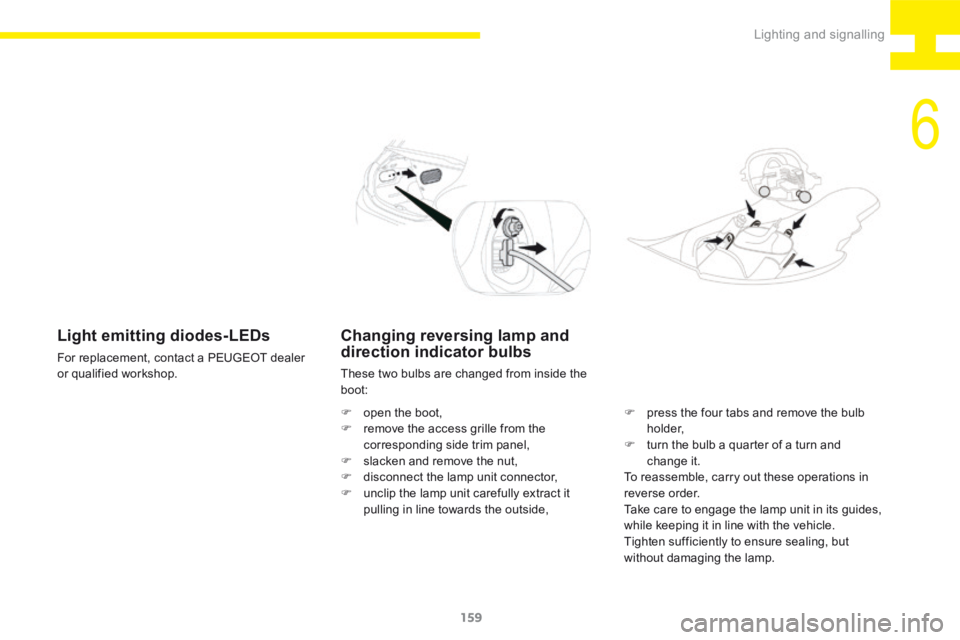
159
208_en_Chap06_Feux-Signalisations_ed01-2015
Changing reversing lamp and
direction indicator bulbs
These two bulbs are changed from inside the
boot:
F open the boot,
F remove the access grille from the
corresponding side trim panel,
F slacken and remove the nut,
F disconnect the lamp unit connector,
F unclip the lamp unit carefully extract it
pulling in line towards the outside, F
press the four tabs and remove the bulb
h o l d e r,
F turn the bulb a quarter of a turn and
change it.
To reassemble, carry out these operations in
reverse order.
Take care to engage the lamp unit in its guides,
while keeping it in line with the vehicle.
Tighten sufficiently to ensure sealing, but
without damaging the lamp.
Light emitting diodes-LEDs
For replacement, contact a PEUGEOT dealer
or qualified workshop.
6
Lighting and signalling
Page 170 of 341
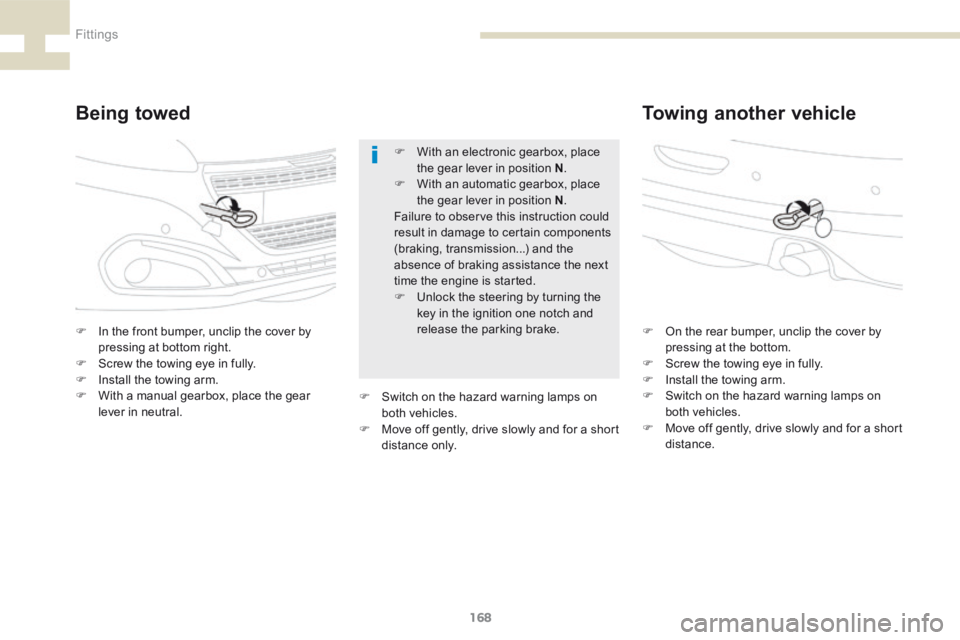
168
208_en_Chap07_ Amenagements_ed01-2015
Being towedTowing another vehicle
F In the front bumper, unclip the cover by
pressing at bottom right.
F Screw the towing eye in fully.
F Install the towing arm.
F With a manual gearbox, place the gear
lever in neutral. F
On the rear bumper, unclip the cover by
pressing at the bottom.
F Screw the towing eye in fully.
F Install the towing arm.
F Switch on the hazard warning lamps on
both vehicles.
F Move off gently, drive slowly and for a short
distance.
F
With an electronic gearbox, place
the gear lever in position N .
F With an automatic gearbox, place
the gear lever in position N .
Failure to observe this instruction could
result in damage to certain components
(braking, transmission...) and the
absence of braking assistance the next
time the engine is started.
F Unlock the steering by turning the
key in the ignition one notch and
release the parking brake.
F Switch on the hazard warning lamps on
both vehicles.
F Move off gently, drive slowly and for a short
distance only.
Fittings
Page 282 of 341

280
208_en_Chap9b_SMEGplus_ed01-2015
Radio
QUESTIONANSWER SOLUTION
The quality of reception of
the radio station listened
to gradually deteriorates
or the stored stations do
not function (no sound,
87.5 Mhz is displayed...). The vehicle is too far from the transmitter used by the station
listened to or there is no transmitter in the geographical area
through which the vehicle is travelling.
Activate the "RDS" function by means of the
short-cut menu to enable the system to check
whether there is a more power ful transmitter in
the geographical area.
The environment (hills, buildings, tunnels, basement car parks...)
block reception, including in RDS mode. This phenomenon is normal and does not
indicate a fault with the audio system.
The aerial is absent or has been damaged (for example when going
through a car wash or into an underground car park). Have the aerial checked by a PEUGEOT dealer.
I cannot find some radio
stations in the list of
stations received. The station is not received or its name has changed in the list.
Press and hold the "List" button at the steering
mounted controls to update the list of stations
received or press on the system update function:
"Update list".
Some radio stations send other information in place of their name
(the title of the song for example).
The system interprets this information as the name of the station.
The name of the radio
station changes.
Audio and Telematics